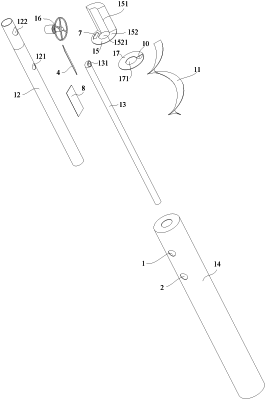| CPC F25B 43/006 (2013.01) [F25B 2500/28 (2013.01)] | 20 Claims |

|
1. A gas-liquid separation device, comprising:
a cylinder, the cylinder defining a first cavity, a second cavity and a third cavity, the first cavity being in communication with the second cavity, the second cavity being in communication with the third cavity;
an external port, the external port comprising a first port, a second port and a third port, the first port being in communication with the first cavity, the second port being in communication with the second cavity;
an adapter, the adapter being at least partially disposed in the cylinder, the adapter defining a first channel and a second channel, a lower end of the second channel and a lower end of the first channel being both located in the third cavity, the lower end of the second channel being lower than the lower end of the first channel, the second channel being in communication with the first cavity and the third cavity; and
a gas-liquid separation component, the gas-liquid separation component being located in the third cavity, and being adapted to separate a gas-liquid two-phase refrigerant that enters the third cavity from the second cavity;
wherein when the gas-liquid separation device is in a first working state, the first channel is closed so that the third port is not in communication with the third cavity; the first port serves as an inlet, and the second port serves as an outlet;
when the gas-liquid separation device is in a second working state, the first channel is opened so that the third port is in communication with the third cavity; the second port serves as an inlet, the first port being in communication with the second channel serves as an outlet for a liquid-phase refrigerant after being separated from the gas-liquid two-phase refrigerant, and the third port being in communication with the first channel serves as an outlet of a gas-phase refrigerant after being separated from the gas-liquid two-phase refrigerant; or, the first port serves as an inlet, the second port serves as an outlet for the liquid-phase refrigerant or an outlet for the gas-liquid two-phase refrigerant, and the third port being in communication with the first channel serves as an outlet for the gas-phase refrigerant after being separated from the gas-liquid two-phase refrigerant.
|
|
17. A gas-liquid separation device, comprising:
a cylinder defining a first cavity, a second cavity, a third cavity, a first port, and a second port, the first port communicated with the first cavity, the second port communicated with the second cavity, the first cavity communicated with the second cavity, the second cavity communicated with the third cavity;
a first connecting pipe comprising an inner portion disposed in the cylinder and an outer portion extending out of the cylinder, the first connecting pipe defining a first channel, the outer portion defining a third port, a lower end of the first connecting pipe located in the third cavity;
a switch disposed on the first connecting pipe, the switch controlling a communication state between the third port and the third cavity;
a second connecting pipe at least partially disposed in the first channel, the second connecting pipe defining a second channel, the second channel communicated with the first cavity and the third cavity; and
a gas-liquid separation component located in the third cavity, the gas-liquid separation component disposed between an outer wall of the first connecting pipe and an inner wall of the cylinder;
wherein the gas-liquid separation device has a first working state and a second working state, when the gas-liquid separation device is in the first working state, the third port is not in communication with the third cavity, one of the first port and the second port serves as a refrigerant inlet, and the other one of the first port and the second port serves as a refrigerant outlet;
when the gas-liquid separation device is in the second working state, the third port is in communication with the third cavity through the first channel, one of the first port, the second port and the third port serves as a refrigerant inlet, and the other two of the first port, the second port and the third port serve as refrigerant outlets.
|